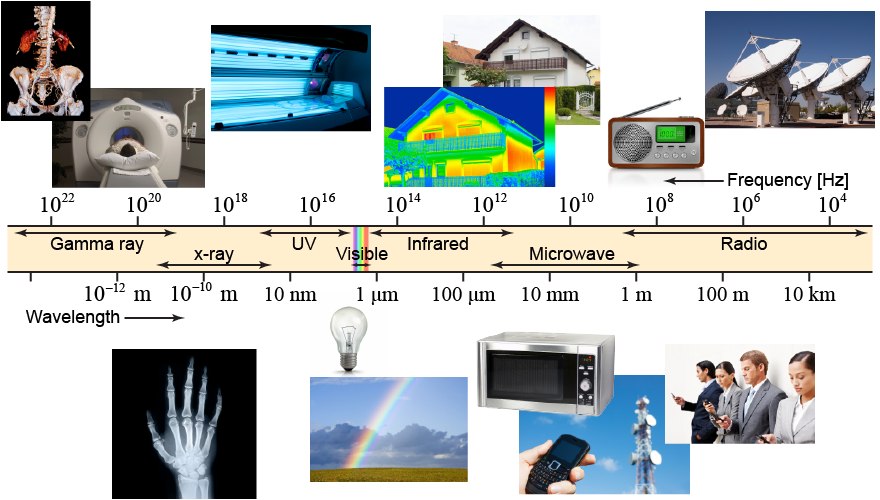|

|
There is a lot more to electromagnetic radiation than meets the eye! While our eye detects visible light, there are many other wavelengths of light—such as gamma rays, infrared radiation, and radio waves—that together comprise a spectrum of EM waves. The broad variety of EM waves are referred to as a spectrum because they span a wide range—many orders of magnitude—in frequency, wavelength, and energy. 
|
The term orders of magnitude refers to powers of 10. If a quantity spans one order of magnitude, then it varies by a factor of 10. Two orders of magnitude are a factor of 102 = 100, three orders of magnitudes are 103 = 1,000, and so on. Mathematically, powers of 10 are expressed as the exponent n in 10n. 
|
The electromagnetic spectrum spans many orders of magnitude in the frequency of EM waves. In the illustration above, you can read off the frequencies and wavelengths associated with each region of the EM spectrum. From the lowest frequency radio waves at 103 Hz to the highest frequency gamma rays at 1023 Hz (and higher), the EM spectrum spans over 20 orders of magnitude in frequency! 
 |
The lowest frequency radio waves used to communicate with submarines are at frequencies below 103 Hz (or 1 kHz). Radio waves vary from 104 Hz (10 kHz) to around 109 Hz (1 GHz). Mobile phone technology and other mobile radios continue the radio band up to 1011 Hz (100 GHz). The infrared spectrum ranges from 1011 to around 4×1014 Hz. Visible light is in a comparatively narrow range of frequencies near 6×1014 Hz. Ultraviolet radiation continues the EM spectrum at higher frequencies of around 1015 to 1017 Hz. X-rays and gamma rays are the highest frequencies, reaching as high as 1023 Hz and higher. 
|
Electromagnetic waves are transverse waves that can propagate through a vacuum, whereas sound waves are longitudinal pressure waves that must travel through a medium. Our eyes can only detect a narrow sliver of the EM spectrum—less than one order of magnitude—but our ears can detect several orders of magnitude of frequency for sound. Modern instrumentation can detect a broader range of the EM spectrum than the sound spectrum. Our eyes see colors within the EM spectrum that are composites of three primary colors (red, green, and blue), whereas our ears can sense many different frequencies of sound simultaneously. 
|
|
Light traveling through a vacuum always has the same speed: c = 3.00×108 m/s. When light passes through a different medium, however, its speed is slower and it changes wavelength—but its frequency stays the same. Use the interactive equation at left to study how the speed, frequency, and wavelength of light vary when light passes through a medium other than a vacuum. Note that if you try to solve for the frequency, then you cannot input a different speed of light. Also, you cannot choose values of f or λ that would cause the speed of light in the medium to be greater than c. (Think about why this should be the case!)
|
What part of the electromagnetic spectrum do each of the following frequencies or wavelengths fall under? - 1020 Hz
- 50 m
- 10−8 m
 |
From the diagram above, the answers are - gamma rays,
- radio waves, and
- UV rays.

|

